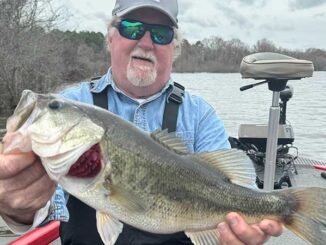
Louisiana Department of Wildlife and Fisheries Biologists examined a variety of Florida Largemouth Bass fingerlings and assisted in placing the fish in suitable habitats along the Red River in Avoyelles and Rapides parishes for the Red River Waterway Commission.
“We’re the liaison,” explained LDWF Fisheries Biologist Talon Jeppson. “We make sure the quantity is correct, we do genetic testing and then we put them in the best habitat for their growth and development.”
The fish were supplied by American Sportfish Hatchery of Montgomery, Alabama, and included pure Florida Bass as well as F1 “Tiger” bass that are a cross of Northern Bass and Florida Bass. Approximately 18,000 largemouth bass fingerlings were placed into the Red River. The fingerlings were 4-6 inches in length, with 7,200 Florida Largemouth Bass fingerlings and 1,800 F1 fingerlings released into the Red River around the Ben Routh Recreation Area in Effie in Avoyelles Parish.
Additional releases were conducted at the Fort Buhlow Lake Landing as well as the Boyce Recreation Area sites managed by the Red River Waterway Commission. Each of those sites received 3,600 pure Florida Bass and 900 F1 bass. Additional releases are scheduled later this month at RRWC sites along the Red River near Natchitoches and in Shreveport.
Dustin Hayes, Marketing Director for the Red River Waterway Commission, said the organization brings in the bass fingerlings to help rebuild the population after habitat was damaged by severe flooding in 2015 and 2016.
“That flooding washed away habitat and washed away a lot of vegetation,” he said. “It’s coming back. We’re trying to do what we can to get the bass population and size back up. Our mission is to promote the recreation and economic development of the river, and this is a critical piece of supporting the recreation side. It’s essential that we get the fish population and size back to where it was before the floods.”
Shawn McNulty, owner of American Sportfish Hatchery, explained the F1 bass are a mix of Northern Largemouth Bass, which are native to Louisiana, and Florida Largemouth Bass.
“You get the aggression of the Northern Bass and the size of the Florida Bass,” he said.
McNulty cited Lake Claiborne as an example of a successful stocking program.
“Their tournament weights have jumped 10 pounds since we started stocking that lake,” he said. “Bringing in new genetics always invigorates the system.”
“It’s good to get those genetics into our water bodies,” Jeppson said, adding that the pure Florida Largemouth Bass can breed with the native Northern Largemouth Bass to create natural F1 bass. “Within a year, the bass we are releasing today will be able to breed. And then in year two they will be large enough to catch, and they will continue growing throughout their life.”
For more information about recreational fishing from the Red River Waterway Commission, visit their website at https://redriverwaterway.com/


